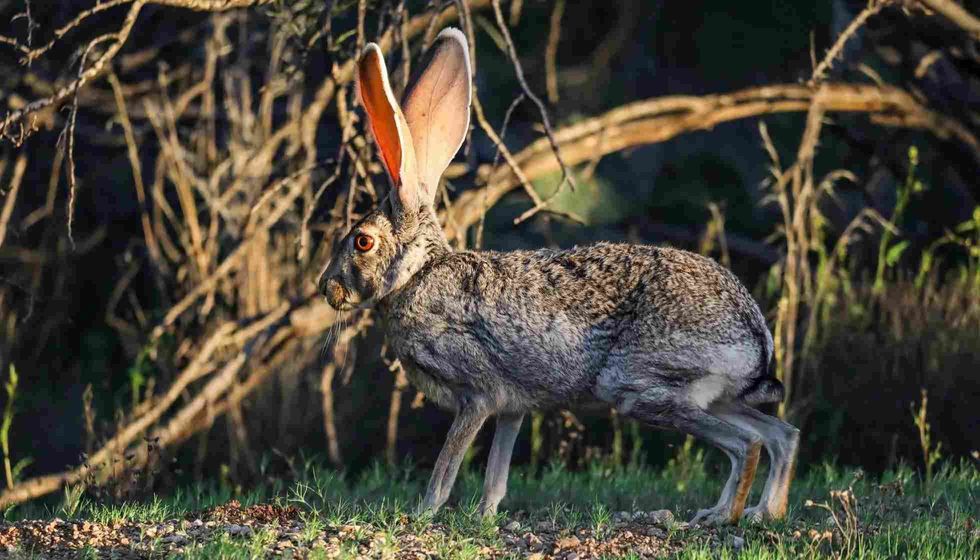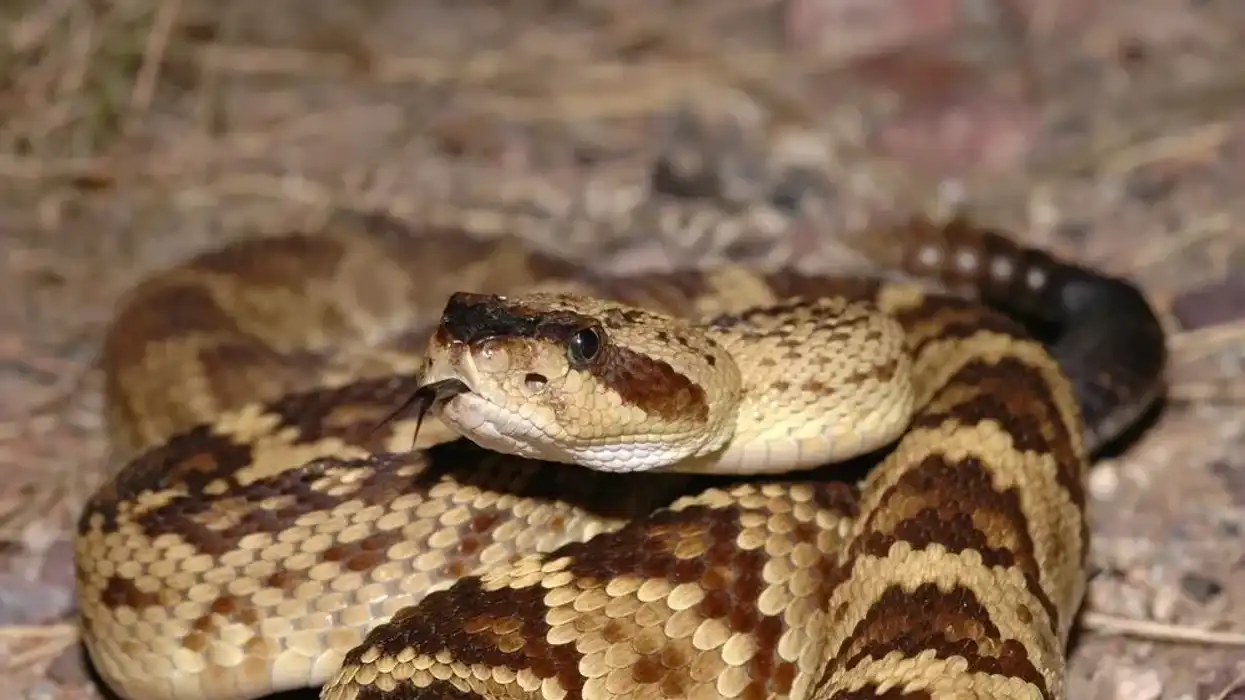The black-tailed jackrabbit (Lepus californicus), also known as the American desert hare, is native to Mexico and western United States. It is one of the largest North American species.
The young ones start moving just after the birth and the mother does not go with them. These rabbits are great prey for some large predators like raptors, eagles, owls, hawks, and other mammals. They look the same as normal rabbits in appearance, but they have a black tail which differentiates them from other rabbit species.
These rabbits usually prey on lice, fleas, ticks, and mites and therefore people avoid having them as a pet. This rabbit is edible and those who are enjoy eating rabbit meat, it is a considered a delicacy.
The young ones are born with open eyes and their bodies covered with fur. Rabbits are cute and adorable, however, they are known to destroy crops in farmlands as they feed on them.
For more relatable content, check out these white-tailed jackrabbit facts and desert hare facts for kids.
Black-Tailed Jackrabbit Interesting Facts
What type of animal is a black-tailed jackrabbit?
The black-tailed jackrabbit (Lepus californicus) is a type of hare and not really a rabbit species. They have long ears and furry bodies.
What class of animal does a black-tailed jackrabbit belong to?
Black-tailed jackrabbits belong to the class Mammalia and phylum Chordata. They have hind legs and long ears in comparison to those of a rabbit.
How many black-tailed jackrabbits are there in the world?
There are different species of hares and rabbits but the definite number of Lepus californicus present across the world is unknown. They are highly reproductive animals and multiply at a great rate.
Where does a black-tailed jackrabbit live?
The black-tailed jackrabbit can be found in scrublands, farms, American deserts, and more open spaces. They eat desert plants like cacti and sagebrush and digest large quantities of plants and grasses.
What is a black-tailed jackrabbit's habitat?
The black-tailed jackrabbit habitat involves large areas with almost no trees and black tailed jackrabbit adaptations mean they can survive in hot climates. This is due to their long ears.
There are a total of six species of jackrabbit and four are found in North America whereas the rest of the species reside in Mexico and south to Baja California. Their widespread range is much more in the western United States.
Who do black-tailed jackrabbits live with?
The jackrabbit population does not live individually and this hare takes rest under the shade of trees during the daytime in extremely hot weather. They do not live in burrows. They feel safe and therefore forage in groups using their eyes and ears as protection for each other against black-tailed jackrabbit predators.
How long does a black-tailed jackrabbit live?
Facts about the black-tailed jackrabbit reveal that the average life span is about two to five years in the wild, while they can survive up to seven years in captivity.
How do they reproduce?
Black-tailed jackrabbit hares follow polyandrous habit while mating, meaning males and females reproduce after chasing each other and act aggressively before mating. Females can have an average of four litters at once and the young ones are born with a full-body covered with fur and their eyes open.
The gestation period is around 41-47 days. The female look around for the small ones for about two to three days to protect them from predators and leaves them to chase predators away.
Females prefer giving birth in thick bushes to protect themselves from predators. Young females tend to grow bigger than males.
What is their conservation status?
The conservation status of the black-tailed jackrabbit is Least Concern which means they are not threatened. At times, the population number goes as high as nearly 470 animals per 0.4 sq mi (1 sq km), but the population of hares may vary every six to 10 years.
This is mainly due to the decreasing number of predators in forests. Also, their range of habitat can be found in farmlands.
Black-Tailed Jackrabbit Fun Facts
What do black-tailed jackrabbits look like?
The black-tailed jackrabbit size measures up to 18-25.6 in (45.7-65 cm) and the tail measures from 2-4.4 in (5-11.2 cm). They have ears which are around 4-5.1 in (10.1-13 cm) in size.
These hares are slimmer than rabbits and with longer ears and legs and the tail has black tips and fur. They have a black stripe at the downward area of the back.
The litters are born with open eyes and whole bodies covered with fur. They have front legs and large hind feet which are up to 5 in (12.7 cm) long. Their habitat range can be found in the American desert, western United States, Baja California and south-central Mexico.
They are wild animals which can not be adopted and kept as pets as they are unpredictable. The color of their fur ranges from white to gray to brown.
Compared to males, females are larger than them. Their black tail and long ears differentiate them from other rabbit species.

How cute are they?
They are wild animals and are prey for many predators like raptors, hawks, eagles, owls, and other small mammals and are always ready for danger so they are admired.
How do they communicate?
Usually, these hares do not make much noise but when they want to communicate with other members of species, they are found making noise by using their hind feet. They use tactile and chemical means of communication.
How big is a black-tailed jackrabbit?
Their body size range is around 18-25.6 in (45.7-65 cm), which is 20 times bigger than a rabbit.
How fast can a black-tailed jackrabbit run?
A hare can run at a speed of 30 mph (48 kph) and has the ability to jump 20 ft (6 m) long when predators are hunting them. They move in a zig zag pattern and jump very high with the help of their long legs.
How much does a black-tailed jackrabbit weigh?
A hare weighs up to 3-6 lb (1.4-2.7 kg).
What are the male and female names of the species?
There is no such names for the male and female species and therefore males are called male black-tailed jackrabbit and females are called female black-tailed jackrabbit.
What would you call a baby black-tailed jackrabbit?
Baby black-tailed jackrabbits are known as leverets.
What do they eat?
This population of hares are herbivores which means they survive on plants. The black tailed jackrabbit diet contains a variety of plants, grasses, shrubs, leaves and fruits and they sometimes also feed on flowering plants.
They get both food and water from plants because some of the plants in the desert area start getting dry during the summer season. It is really important for them to feed mostly on plants with moisture.
The young ones or the leverets' diet consists of puppy food right after birth. The water from the rabbit body is replaced by the water rich vegetation and therefore their diet switches to shrubs when vegetation is recovering from foraging.
Are they dangerous?
They are not dangerous animals. Those raised as pets are quite friendly and adorable. However, one must be careful when approaching wild ones as they are not tamed.
Would they make a good pet?
The black-tailed jackrabbit's scientific name reveals that it is a hare, not a rabbit. This animal would not make a good pet because they are unpredictable and needs a lot of care. These hares are known to be wild animals and are not safe to keep as pets, not even the litters.
Did you know...
The black-tailed jackrabbit skull is sold for around $46.
How high can black-tailed jackrabbits jump?
They can jump up to 20 ft (6 m) long making zig zag patterns while being chased by predators. Normally, they can hop up to 5-10 ft (1.5-3 m) in length.
They can also run at a speed of 30-40 mph (48-64 kph). When they move in the forest areas, their fourth or fifth step is usually higher to check whether there are predators around them or not.
Why is the black-tailed jackrabbit an invasive species?
Yes, the black-tailed jackrabbit is an invasive species as their natural predators are removed from the forest. These hares can cause damage to forests by eating a lot plants and harming the environment.
Here at Kidadl, we have carefully created lots of interesting family-friendly animal facts for everyone to discover! Learn more about some other mammals from our European rabbit facts and Arctic hare facts pages.
You can even occupy yourself at home by coloring in one of our free printable Black tailed jackrabbit coloring pages.









